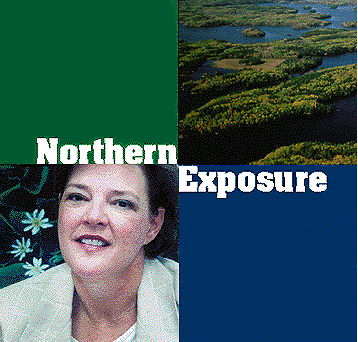
The University of Chicago Magazine
April 1997

As the top ranger at Voyageurs National Park, Barbara West, AB'70, finds that conflicts between the park and its Minnesota neighbors regularly heat things up.
By Debra Shore
A ten-speed bike leans upended in one corner. A stack of videotapes with titles like Performance Sea Kayaking perches on the cluttered desk. A sturdy woman with short, reddish-brown hair talks on the phone, deliberating about the color of a loaner pickup truck she plans to drive next week to meetings in Sault Sainte Marie. Blue or white? "Just not that puky green," she says with a laugh. "Just not that Forest Service green."Her office is decidedly unimpressive, a small room in a former automobile dealership whose onetime service bays provide handy storage for a fleet of snowmobiles, trucks, and boats. But down the road a piece lies her real, spectacular domain: Voyageurs National Park.As superintendent of Voyageurs, Barbara West, AB'70, oversees 219,000 acres of magnificent North Woods Minnesota, a series of lakes and the heavily-wooded Kabetogama Peninsula, where bald eagles soar and timber wolves roam, where the call of the loon and the splash of beaver tails evoke the dipping paddles of the French-Canadian voyageurs who plied these trade routes centuries ago and for whom the park is named. West, who is one of six women out of 56 National Park superintendents in the U.S., presides over a summer playground and winter wonderland that 240,000 people visit annually to fish and paddle, camp and hike, navigate via snowmobiles and houseboats, or explore on snowshoes and skis.
If that job description summons up images of serenity, West hastens to add that her post often feels like a hot seat. Since her June 1995 start at Voyageurs, she's been called to testify at four congressional hearings on who has the right to decide park policy: the Park Service or the local community. The issues range from motorized access throughout the park to the number of houseboat campsites slated for development. She's in the midst of a mediation process to ease community tensions over the management of Voyageurs and its federal neighbor, the Boundary Waters Canoe Area wilderness, administered by the U.S. Forest Service. And one controversial decision--barring snowmobile traffic on several frozen lake bays to protect roving wolf packs--landed West on the CBS Evening News this past winter.
In short, West has learned, often painfully, that a federal land manager today is more likely to be the target of scorn and object of lawsuits than a role model for Brownie or Cub Scout troops.
Voyageurs provoked debate even before it was assembled from a patchwork of state parks, national forest, and private holdings a quarter of a century ago. "The edges of hell will freeze over before there is a national park in northern Minnesota," wrote one opponent of the proposed park. Yet by 1969, three out of four Minnesotans polled by the Minneapolis Star-Tribune supported the park's creation, and it was formally established in 1975.
Today, Voyageurs is promoted as the nation's premier water-based park. Water forms one-third of the park: from four large, deep-water lakes to 500 beaver ponds. The watery terrain is punctuated with sandy beaches, rocky bluffs, and hundreds of islands, coves, and bays. The 75,000-acre Kabetogama peninsula, bordered on one side by Rainy Lake and on the other by Namakan and Kabetogama lakes, stretches 26 miles and hides dozens of pristine lakes and tiny, glacier-carved rock basins accessible only by foot trails, canoe portages, or floatplanes. Voyageurs is also home to some 100 bald eagles, as well as timber wolves, pine martens, loons, black bear, moose, beaver, otter, fisher, osprey, and 48 species of fish.
The park, which shares 55 miles of boundary with Canada, was established in part to protect the geologic, scenic, natural, and recreational resources of the Minnesota North Woods. It also commemorates the route of the French-Canadian fur traders--the voyageurs--who for nearly 150 years in the 18th and early 19th centuries explored the maze of lakes and streams in 25-foot birch-bark canoes, transporting vast quantities of furs and other goods between Montreal and the far northwest.
Within the park, archaeologists have found evidence of human occupation dating back 100 centuries, including artifacts from early woodland tribes and the Chippewa. Another area was once a rowdy transient community of almost 200 lumberjacks, prospectors, and Prohibition-era bootleggers. Now the paper manufacturer Boise Cascade is the largest employer in International Falls, a well-insulated community of 8,325 where the park's headquarters is located. The putative model for "Frostbite Falls" of Rocky and Bullwinkle fame, the town bills itself "Icebox of the Nation" and celebrates its singularly frigid status with the annual Icebox Days in January when revelers engage in turkey bowling, mutt races, and a Freeze Your Gizzard Blizzard Run. For most of its citizens, life in International Falls revolves around fishing and hunting seasons and the long wait for winter to loosen its grip on the land.Continue reading "NORTHERN EXPOSURE"
Above photos: Barbara West oversees 219,000 acres of magnificent North Woods Minnesota, a series of lakes and the heavily-wooded Kabetogama Peninsula where bald eagles soar-and snowmobiles roar. (West portrait: Bob King/Duluth News-Tribune; Park photo courtesy of Voyageurs National Park.)
Go to:
- INVESTIGATIONS
- CHICAGO JOURNAL
- EVENTS
- LETTERS
- CHICAGOPHILE
- Feature story, "Just what the doctors ordered"
- Feature story, "Top of his game"
- Special Report, "Reel scholarship"
- Feature story, "Northern exposure"
- CLASS NEWS
- DEATHS
- BOOKS BY ALUMNI
- IN THE CLUBS
Return to April 1997 Table of Contents